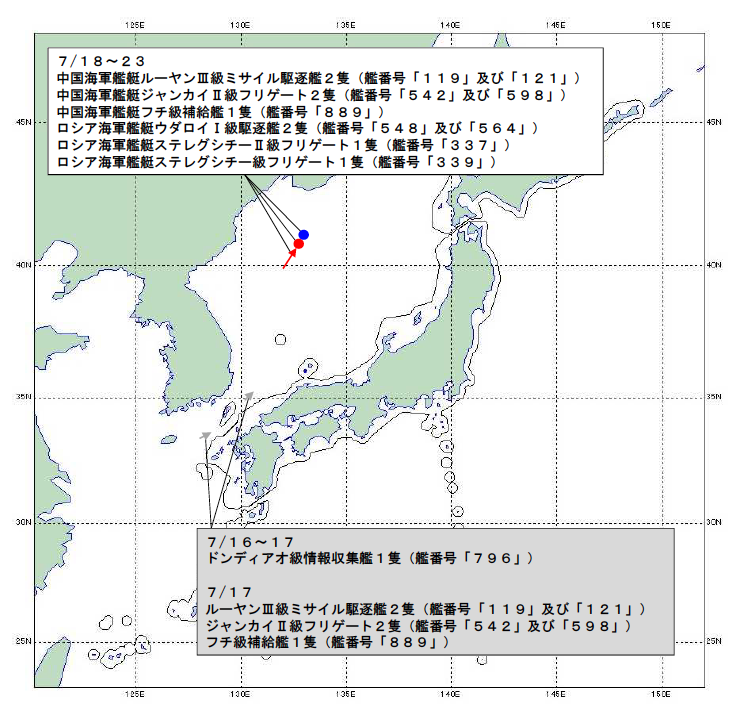
The People’s Liberation Army Navy and Russian Navy wrapped up their joint exercise “Northern Interaction 2023” in the Sea of Japan Sunday before the combined fleet arrived at Vladivostok Monday, where the PLAN ships are making a port visit.
The Northern Interaction 2023 exercise began Thursday and involved a PLAN Surface Action Group consisting of destroyers CNS Guiyang (119) and CNS Qiqihar (121), frigates CNS Zaozhuang (542) and CNS Rizhao (598) and fleet oiler CNS Taihu (889) and a Russian Navy SAG made up of destroyers RFS Admiral Panteleyev (548) and RFS Admiral Tributs (564) and corvettes RFS Gremyashchiy (337) and RFS Hero of the Russian Federation Aldar Tsydenzhapov (339).
Russia’s Ministry of Defense, which issued statements and updates throughout the exercise on their social media channel, said 20 combat exercises were carried out during the drills, including joint naval firing at sea, coastal and air targets.
These included:
- An air defense exercise used simulations of an attack on warships from various directions by anti-submarine aircraft and fighters of the naval aviation of the Russian Pacific Fleet and the People’s Liberation Army. The ships’ crews also trained to detect and destroy unmanned aerial vehicles.
- Naval guided-missile strikes against coastal targets with targeting guidance provided by naval aviation aircraft.
- Surface gun fire with the Russian ships firing at targets at a range of more than five kilometres with 100mm A-190 and Ak-100 naval guns. The PLAN ships hit targets with 130mm H/PJ-38 and 76mm H/PJ26 naval guns
- Anti-Submarine search and dislodge exercise where a Ka-27PL anti-submarine helicopter and shipboard sonars searched for and detected a mock submarine.
- Expulsion of a mock intruder ship from an area closed to navigation where Russian and Chinese sailors jointly practiced implementing a set of standard measures aimed at forcing the ship to leave a restricted area.
- Destroying a mock sea mine and repelling an attack by a high-speed small craft.
Navigation, joint communications and search and rescue drills were also carried out in the exercise.
In contrast to joint exercises in previous years, which had been carried out in Japan’s Exclusive Economic Zone (EEZ) along with joint sailing near Japan, the Northern Interaction 2023 exercise took place in international waters in the Sea of Japan, with Japan monitoring the exercise, despite the distance.
The Joint Staff Office (JSO) of Japan’s Ministry of Defense issued a release Monday stating that at 1 p.m. July 18, the PLAN and Russian Navy ships had been sighted 400km north of the Oki Islands, which lie off the southwest coast of the main island of Honshu. The Chinese and Russian ships conducted various naval exercises in the area from July 18 through Sunday.
Japan Maritime Self Defense Force (JMSDF) destroyer helicopter carrier JS Hyuga (DDH-181), destroyer escort JS Chikuma (DE-233) and JMSDF P-3C Orions Maritime Patrol Aircraft (MPA) of Fleet Air Wing 2, stationed at JMSDF Hachinohe Air Base, Honshu, monitored the Russian and Chinese ships, according to the release.

On Monday night, following the arrival of USS Annapolis (SSN-760) at Jeju Island, South Korea, North Korea launched two ballistic missiles into the Sea of Japan. The missiles were launched from inland North Korea and fell in the Sea of Japan on the east side of the Korean Peninsula and outside Japan’s EEZ, according to a Tuesday Japan Ministry of Defense release. The first missile launched at around 11:54 p.m. and flew about 350km at a maximum altitude of about 100km, while the second was launched at around 11:59 p.m. and flew about 400km at a maximum altitude of about 100km.
Japan’s Prime Minister Fumio Kishida convened an emergency gathering to discuss responses, according to the release. He instructed the Ministry of Defense to make every effort to collect and analyze information in close cooperation with the U.S., South Korea and other countries and continue to take all possible precautions in vigilant monitoring in preparation for the occurrence of unforeseen circumstances.
“North Korea’s series of actions, including its repeated ballistic missile launches, threaten the peace and security of Japan, the region, and the international community. In addition, such ballistic missile launches violate relevant Security Council resolutions and constitute a serious public safety issue. Japan lodged a strong protest against North Korea and strongly condemned it,” reads the release.
Monday’s launches appears to be part of North Korea’s routine response to port visits to South Korea by U.S. carriers and submarines.
North Korea launched two ballistic missiles in March this year, just a day before the Nimitz Carrier Strike Group docked at Busan for a port visit. It also launched two ballistic missiles into the Sea of Japan July 19 following the port visit of Ohio-class nuclear ballistic missile submarine USS Kentucky (SSBN-737), which arrived at Busan on July 18.





